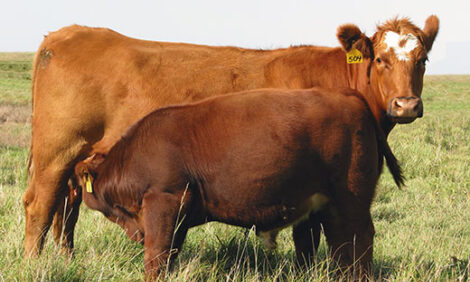



DM Measurements in Maize Silage Now More Precise
DENMARK - A new cutter head for the long power-driven silage probe gives a more precise determination of the dry matter content of maize silage, according to a test at the Danish Cattle Research Centre.The increasing height of the silage silos has necessitated the development of sampling techniques for the silage. Originally silage samples were extracted by pushing the probe into the silage. The next step was changing the corer into an auger so you could drill down into the silage. This was initially done by hand-power, but as the silos continued to grow taller, ‘Frøsalget’ and agricultural advisers developed a power-driven silage probe that enabled samples to be taken down to 5 m depth.
Dry matter values too high
Photo: Danish Cattle Research Centre
The Danish Cattle Research Centre (KFC) also started using the long probe to sample silage for feed analysis. However, they discovered that samples from maize silage taken from larger depths with this probe gave dry matter contents that were 2-4 per cent higher than from the pre-ensiled samples. If a probe was inserted by hand-power, there was no such difference.
KFC, the Faculty of Agricultural Sciences (DJF) and the Danish Cattle Federation therefore joined forces to carry out a test of the power-driven silage probe in a 3-m tall bunker silo with maize silage, and comparing these samples with samples that were taken horizontally using a short silage probe and with vertical sampling with the silage probe used by the Dutch laboratory Blgg. The test confirmed that the dry matter content measured with the long silage probe was too high, both compared with the horizontally extracted samples and with the samples extracted with the Blgg silage probe.
New cutter head developed
In collaboration with ‘Frøsalget’ a new cutter head was therefore developed. The hypothesis was that the sample material inside the probe squeezed the water out from the silage ahead of the cutter head due to the large friction inside the probe. In other words, the sample material inside the probe was strongly compressed and the problem increased with increasing sampling depth.
The test also showed that the problem with the high dry matter levels could be partly alleviated by emptying the silage probe for every 50 cm instead of for every metre, which is the normal procedure. The opening on the original cutter head is 39 mm, while the internal diameter in the pipe is approx. 45 mm. In order to get the sample material to take up less space, ‘Frøsalget’ had cutter heads produced with openings measuring 33, 35, 37 and 39 mm while they also made the inside of the probe conical and the walls less thick to create more space.
A smaller diameter for power-driven silage probes is recommended
A new test at KFC shows that when the cutter heads with diameters of 33, 35 or 37 mm were used, the results were all in good agreement with the horizontally extracted samples, while both the new and the old 39-mm cutter head gave a higher dry matter content.
When samples are taken in maize silage with a power-driven silage probe, it is therefore recommended that you change to a cutter head with a smaller diameter. The new cutter heads are currently being tested in grass silage. The results will help determine whether the new standard should be 33, 35 or 37 mm. The new cutter head is expected to be ready this year.
| Dry matter content in maize silage samples extracted with different cutter heads | ||||||
|---|---|---|---|---|---|---|
| Cutter head diameter) | Original cutter head, 39 mm | New cutter head, 39 mm | New cutter head, 37 mm | New cutter head, 35 mm | New cutter head, 33 mm | Horizontal extraction (original cutter head, 39 mm) |
| Dry matter, % | 36.3 | 34.7 | 32.9 | 33.2 | 32.9 | 33.4 |
TheCattleSite News Desk


